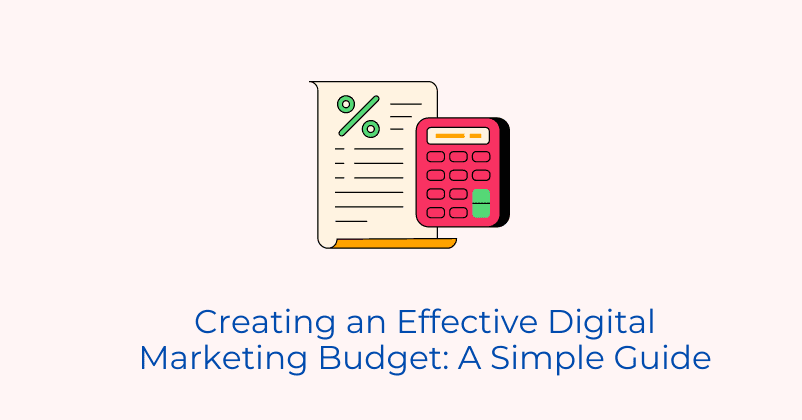Digital Marketing Budget: Why It Matters and How to Get It Right
When it comes to digital marketing, your budget is the backbone of your strategy. It’s not just about how much you spend but how wisely you allocate those funds.
Without a clear budget, it’s easy to overspend on areas that might not bring the best return on investment or miss out on key opportunities that could drive growth.
A well-planned budget ensures every Rupee works hard, driving real results for your business. It allows you to plan your campaigns effectively, track your spending, and adjust strategies based on what’s working.
Here’s What We Will Cover in This Blog:
- Why You Need a Digital Marketing Budget
- Key Components of a Digital Marketing Budget
- How to Determine Your Digital Marketing Budget
- Strategies to Optimize Your Digital Marketing Budget
- Common Mistakes to Avoid When Setting a Digital Marketing Budget
- How to Measure ROI and Adjust Your Budget Accordingly
- Example: Setting Up a Digital Marketing Budget for an E-Commerce Business
- Conclusion: The Role of a Thoughtful Budget in Digital Marketing Success
Why You Need a Digital Marketing Budget
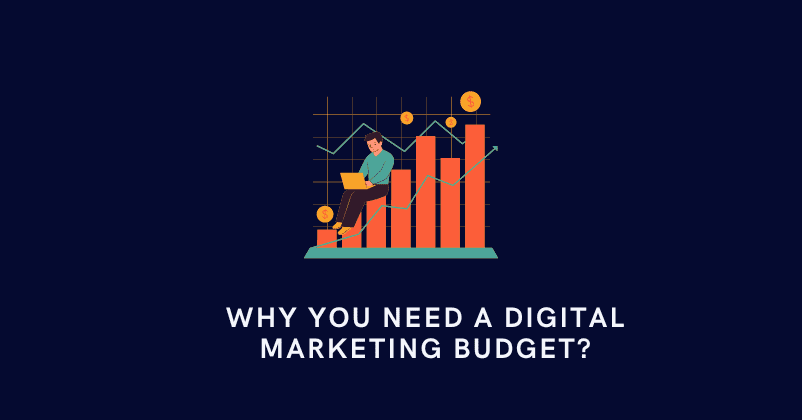
Think of your digital marketing budget as your game plan. Just like in sports, where a well-thought-out strategy leads to victory, a clear budget guides your marketing efforts to success.
It keeps you focused on what matters most and helps you avoid costly mistakes. Without a budget, it’s easy to get sidetracked, spending too much on flashy ads or tools that don’t contribute to your goals.
With a budget in place, you can set clear goals and track your progress. You know exactly where your money is going and what you’re getting in return, ensuring that every investment contributes to your business’s growth.
Example: Imagine you’re planning a family vacation. You wouldn’t just start spending on tickets, hotels, and activities without knowing how much you can afford, right? You’d plan carefully, ensuring you have enough to cover all aspects of the trip, from travel to food to entertainment.
The same goes for digital marketing. Without a budget, you might spend too much on ads and not have enough left for other important areas, like content creation or SEO.
A budget helps you balance everything, so you get the best value for every Rupee you spend. It allows you to invest in the right areas, ensuring a well-rounded approach that maximizes your return on investment.
Key Components of a Digital Marketing Budget
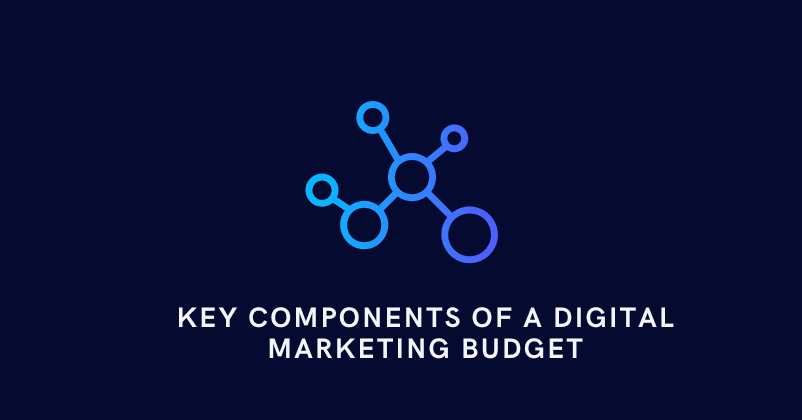
Creating a digital marketing budget isn’t just about setting aside a lump sum of money. It’s about knowing where to invest to get the best results. Let’s break down the key components that should be part of your budget:
1. Paid Advertising Paid advertising is often a significant part of a digital marketing budget. This includes spending on Google Ads, social media ads, and other online platforms where you can target your audience directly.
Investing in paid ads helps you reach your target audience quickly and effectively. But it’s crucial to allocate the right amount to avoid overspending. Think of it as paying for visibility—making sure your brand is seen by the right people at the right time.
2. Content Marketing Content is king, and creating high-quality content should be a priority in your budget. This includes blog posts, videos, infographics, and more.
Content marketing helps build your brand’s authority, engages your audience, and drives organic traffic to your site. Budgeting for content creation ensures you consistently produce valuable content that resonates with your audience.
3. SEO (Search Engine Optimization) SEO is the backbone of your digital marketing efforts. Investing in SEO tools, services, and ongoing optimization is essential for improving your website’s visibility on search engines.
SEO isn’t a one-time thing; it’s an ongoing process. Allocating part of your budget to SEO ensures your site stays competitive and ranks well for relevant keywords.
4. Social Media Management Social media is where your audience spends a lot of their time. Managing and promoting your brand on social platforms requires a dedicated budget.
This includes creating engaging posts, running paid promotions, and interacting with your audience. A well-planned social media strategy can boost your brand’s visibility and connect you with potential customers.
5. Email Marketing Email marketing is one of the most cost-effective ways to reach your audience. Budgeting for email marketing tools, list building, and campaign management is crucial for maintaining regular communication with your customers.
Email campaigns help nurture leads, promote products, and keep your brand top of mind. It’s a direct line to your audience, making it a valuable component of your budget.
6. Website Development and Maintenance Your website is your online storefront. It needs to be well-designed, user-friendly, and regularly updated. Budgeting for website development and maintenance ensures that your site provides a great user experience.
This includes costs for custom designs, responsive development, and ongoing maintenance to keep everything running smoothly.
7. Analytics and Reporting To make informed decisions, you need to know what’s working and what’s not. Budgeting for analytics tools and performance tracking helps you monitor your campaigns and adjust your strategies accordingly.
Data-driven decisions are key to optimizing your budget and maximizing your ROI. With the right tools, you can track your progress and make adjustments to improve your results.
How to Determine Your Digital Marketing Budget
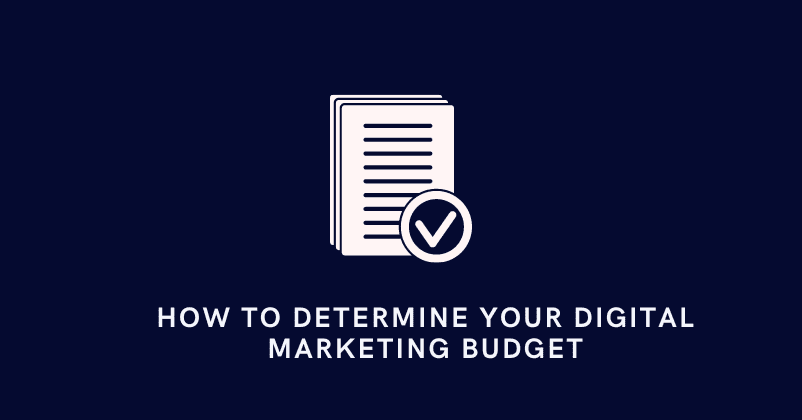
Now that you know the key components, the next step is figuring out how much to allocate to each. Setting a digital marketing budget isn’t a one-size-fits-all process; it depends on your business goals, industry, and target audience. Let’s explore how you can determine the right budget for your needs:
1. Assessing Your Business Goals Start by understanding your business objectives. Are you looking to increase brand awareness, generate leads, or boost sales?
Your goals will guide how you allocate your budget. For example, if brand awareness is your priority, you might spend more on social media and content marketing. If generating leads is your focus, you might allocate more to paid advertising and SEO.
2. Analyzing Past Performance Look at what has worked in the past. If you’ve run digital marketing campaigns before, analyze their performance.
Which channels delivered the best ROI? Which strategies fell short? By reviewing past data, you can make informed decisions on where to invest more and where to cut back. This helps you avoid wasting money on tactics that don’t work.
3. Industry Benchmarks Understanding how much other businesses in your industry are spending on digital marketing can give you a baseline for your budget.
While your budget should be tailored to your specific needs, knowing industry standards can help you set realistic expectations. For instance, if competitors are spending heavily on SEO, you might need to allocate more to stay competitive.
4. Understanding Your Target Audience Your budget should align with the behaviors and preferences of your target audience.
Where do they spend their time online? What type of content do they engage with? Understanding your audience helps you prioritize spending on the channels and strategies that will reach them most effectively.
5. Flexibility and Adjustment Your budget isn’t set in stone. As you run campaigns, you’ll learn what works best and what doesn’t.
Be prepared to adjust your budget as needed. If a particular strategy is delivering great results, consider reallocating more funds to it. On the other hand, if something isn’t working, don’t be afraid to pull back and invest elsewhere.
Strategies to Optimize Your Digital Marketing Budget
Once you’ve set your digital marketing budget, the next step is ensuring that every Rupee is used effectively. Optimization is key to maximizing your return on investment. Here are some strategies to help you get the most out of your budget:
1. Prioritizing Channels and Tactics Not all channels will deliver the same results for your business. It’s important to identify which ones provide the best ROI and focus your budget on those.
For example, if you find that your social media campaigns drive more engagement and conversions than other channels, it might make sense to allocate more of your budget there. The goal is to concentrate your spending on the tactics that deliver the most value.
2. Continuous Testing and Optimization Digital marketing is constantly evolving, so what works today might not work tomorrow. That’s why it’s crucial to continuously test and optimize your campaigns.
Run A/B tests on your ads, email subject lines, and landing pages to see what resonates best with your audience. Use the data you collect to make informed adjustments. Small tweaks can lead to significant improvements in performance, ensuring that your budget is spent wisely.
3. Leveraging Data-Driven Decisions Rely on data, not gut feelings, when making decisions about your budget. Analytics tools can provide insights into how your campaigns are performing, helping you identify areas for improvement.
For instance, if data shows that certain keywords are driving more traffic and conversions, consider investing more in SEO for those terms. By using data to guide your decisions, you can allocate your budget more effectively and avoid wasting money on strategies that aren’t delivering results.
4. Exploring Cost-Effective Marketing Tools There are many marketing tools available, but they don’t all come with a hefty price tag. Some free or low-cost tools can offer significant value and help you stretch your budget further.
Look for tools that can automate repetitive tasks, provide insights, or help you manage your campaigns more efficiently. Investing in the right tools can save you time and money, allowing you to focus more of your budget on high-impact strategies.
5. Reallocating Funds Based on Performance As your campaigns run, regularly review their performance. If you notice that certain strategies are outperforming others, consider reallocating funds to capitalize on that success.
For example, if your content marketing efforts are driving more leads than expected, it might be worth increasing the budget for content creation and promotion. Flexibility is key to making sure your budget is always working as hard as possible.
Common Mistakes to Avoid When Setting a Digital Marketing Budget
Even with the best intentions, it’s easy to make mistakes when setting a digital marketing budget. These errors can lead to wasted resources and missed opportunities. Here are some common pitfalls to watch out for:
1. Underestimating Costs One of the biggest mistakes businesses make is underestimating the true cost of digital marketing.
It’s easy to overlook expenses like tool subscriptions, content creation, or the cost of hiring professionals. When you underestimate costs, you risk running out of funds before your campaigns have a chance to succeed. Always budget a little extra to cover unexpected expenses and ensure you have enough to see your strategies through to completion.
2. Ignoring Hidden Costs Along with underestimating overall costs, it’s also common to forget about hidden expenses.
These might include fees for premium tools, ad platform costs, or outsourcing certain tasks. Hidden costs can quickly add up, eating into your budget. Make sure you account for these when planning your budget so you’re not caught off guard later.
3. Lack of Flexibility A rigid budget can be just as harmful as no budget at all.
Digital marketing is dynamic, and your strategies need room to adapt. If you don’t leave some flexibility in your budget, you may miss out on opportunities or continue spending on tactics that aren’t working. Allow for some wiggle room so you can shift funds to where they’re needed most as your campaigns evolve.
4. Focusing Only on Short-Term Gains Another common mistake is focusing too much on short-term results and not enough on long-term growth.
While it’s important to see quick wins, digital marketing is also about building a sustainable strategy. If you allocate too much of your budget to immediate returns, like pay-per-click ads, you might neglect areas that contribute to long-term success, like SEO or content marketing.
5. Not Setting Clear Goals Without clear goals, it’s impossible to measure the success of your budget.
Vague objectives like “increase traffic” or “boost sales” won’t give you a clear direction on how to allocate your budget. Set specific, measurable goals that align with your business objectives. This will help you distribute your funds more effectively and track your progress accurately.
How to Measure ROI and Adjust Your Budget Accordingly
Once your digital marketing campaigns are up and running, measuring return on investment (ROI) is crucial. Understanding how well your budget is performing allows you to make informed decisions and adjustments. Here’s how to effectively measure ROI and tweak your budget:
1. Setting Clear KPIs Start by defining clear Key Performance Indicators (KPIs) for each campaign.
KPIs are specific metrics that help you track progress toward your goals. These could include conversion rates, click-through rates, lead generation, or customer acquisition costs. By setting clear KPIs, you can easily measure whether your campaigns are delivering the desired outcomes.
2. Tracking Performance Use analytics tools to monitor the performance of your campaigns in real-time.
These tools provide valuable insights into how your audience is interacting with your ads, content, and website. For example, Google Analytics can show you which traffic sources are driving the most conversions, while social media analytics can reveal which posts are getting the most engagement. Regularly tracking performance ensures you stay on top of what’s working and what’s not.
3. Calculating ROI To calculate ROI, compare the revenue generated from your campaigns against the cost of running them.
The formula for ROI is simple: (Revenue – Cost) / Cost = ROI. This calculation gives you a clear picture of which campaigns are profitable and which ones need adjustment. A positive ROI means your campaign is making more money than it costs, while a negative ROI indicates a loss.
4. Adjusting the Budget Based on Results If your ROI calculations show that certain campaigns are performing well, consider reallocating more of your budget to those areas.
On the other hand, if a campaign isn’t delivering the expected results, don’t be afraid to reduce its budget or pause it altogether. The key is to be flexible and responsive. By continuously adjusting your budget based on real-time data, you can maximize your marketing efforts and ensure every Rupee is well spent.
5. Reviewing and Refining Measuring ROI isn’t a one-time task. It’s something you should do regularly, especially as market conditions and customer behaviors change.
Set a schedule for reviewing your budget and campaign performance, whether it’s monthly, quarterly, or after the completion of a significant campaign. Use these reviews to refine your strategy, allocate resources more effectively, and improve your overall marketing results.
Example: Setting Up a Digital Marketing Budget for an E-Commerce Business
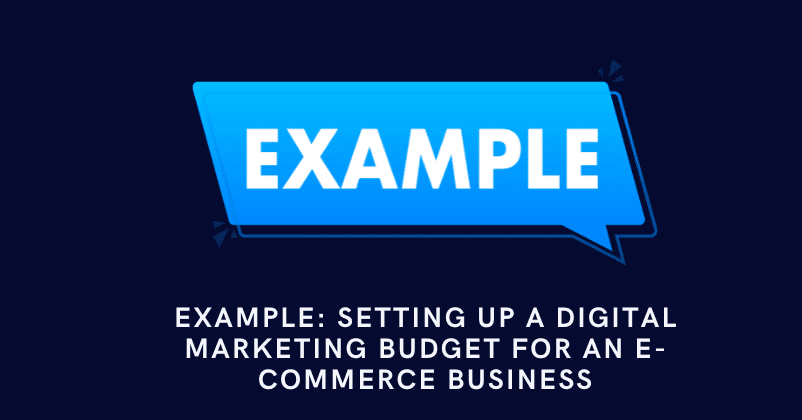 Before you start spending, it’s crucial to understand where your audience hangs out online. This will guide you in allocating your budget where it will have the most impact.
Before you start spending, it’s crucial to understand where your audience hangs out online. This will guide you in allocating your budget where it will have the most impact.
1. Discover Where Your Audience Is
- Social Media: Are your potential customers scrolling through Facebook and Instagram? If so, these platforms should be at the top of your priority list. Visual content thrives here, making it perfect for showcasing fashion accessories.
- Search Engines: If your audience is actively searching for products like yours on Google, then paid search ads (PPC) and SEO are essential. They capture intent-driven traffic, which is already primed to convert.
- Content Consumption: Does your audience consume content through blogs, videos, or platforms like Pinterest? If they do, investing in content marketing will help you engage them with valuable and relevant information.
2. Allocate Your Budget Strategically Let’s say you have ₹5,00,000 to spend on digital marketing for your e-commerce business. Here’s a smart way to allocate that budget:
Paid Advertising: ₹2,00,000
- Reason: Paid ads can quickly drive targeted traffic to your site.
- Allocation: Put ₹1,50,000 into Google Ads for search and display campaigns. Reserve ₹50,000 for social media ads on Facebook and Instagram, where you can visually engage your audience.
Content Marketing: ₹75,000
- Reason: Content is key to building a brand and fostering trust.
- Allocation: Invest in creating blog posts, how-to videos, and social media content that connects with your audience and highlights your products.
SEO: ₹50,000
- Reason: SEO builds long-term organic traffic, which is both cost-effective and sustainable.
- Allocation: Focus on keyword research, on-page SEO, and link-building to ensure your website ranks well in search engine results.
Social Media Management: ₹50,000
- Reason: Social media is where you build relationships with your audience.
- Allocation: Spend on daily posts, engaging content, and direct interaction with followers to keep your brand active and visible.
Email Marketing: ₹25,000
- Reason: Email marketing is a direct and personal way to communicate with your customers.
- Allocation: Use this budget for email campaigns that nurture leads, offer promotions, and encourage repeat business.
Website Development and Maintenance: ₹50,000
- Reason: Your website is the cornerstone of your digital presence.
- Allocation: Allocate funds to keep your website updated, user-friendly, and mobile-optimized, ensuring a smooth shopping experience for your customers.
Analytics and Reporting: ₹25,000
- Reason: You need to know what’s working to make informed decisions.
- Allocation: Invest in analytics tools that provide insights into user behavior, conversion rates, and overall campaign performance.
Flexibility Fund: ₹25,000
- Reason: The digital landscape is always changing. Be ready to adapt.
- Allocation: Keep this fund to seize new opportunities or make quick adjustments when needed.
3. Measure, Learn, and Adjust After running your campaigns, take a step back and analyze the results. Did social media ads generate more sales than expected? Was SEO a significant driver of traffic? Use this data to understand what worked best.
Then, tweak your budget accordingly. If Google Ads are delivering great ROI, consider shifting more funds there. If a particular platform underperformed, reassess its strategy or reduce its budget.
Remember, flexibility is key. Regularly review your campaigns, measure your results, and make adjustments to ensure every Rupee is working hard for you.
Conclusion: The Role of a Thoughtful Budget in Digital Marketing Success
A well-planned digital marketing budget is not just about numbers—it’s about strategy. By understanding where your audience spends their time, you can allocate your resources more effectively. This ensures that every Rupee works towards achieving your business goals.
Remember, your budget should be flexible. As you measure the performance of your campaigns, be prepared to adjust your spending. This will help you maximize your ROI and keep your digital marketing efforts aligned with your objectives.
A thoughtful budget acts as a roadmap for your digital marketing journey. It guides your decisions, helps you avoid costly mistakes, and ensures that your investments bring the desired returns. By following the steps outlined in this article, you can create a digital marketing budget that drives growth and sets your business up for success.
Call to Action: Need Help with Your Digital Marketing Budget?
Creating a digital marketing budget that delivers results requires expertise and experience. If you need guidance in setting up or optimizing your budget, we’re here to help.
Reach out today to Best Digital Marketing Agency in India, and let’s work together to build a budget that drives your business forward.

